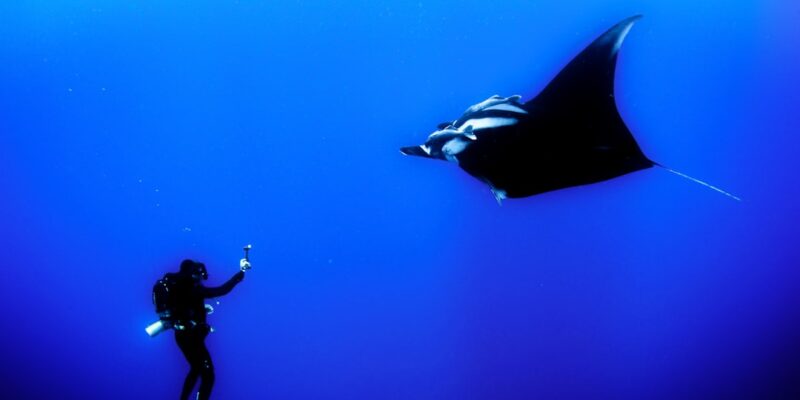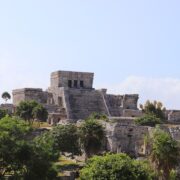
Manta Ray Diving in Indonesia: A Magnificent Underwater Experience
Manta rays are majestic creatures that can be found in oceans all around the world. These gentle giants are known for their graceful movements and impressive size, with some individuals reaching up to 23 feet in wingspan. Manta rays play a crucial role in the marine ecosystem, as they help maintain the health of coral reefs by feeding on plankton and other small organisms.
One of the best places in the world to encounter manta rays is Indonesia. With its vast coastline and diverse marine life, Indonesia offers a unique opportunity for divers to witness these magnificent creatures up close. Manta ray diving has become a popular activity for both experienced divers and beginners alike, as it allows them to explore the underwater world and witness the beauty of these gentle giants.
Key Takeaways
- Manta ray diving in Indonesia offers a unique and unforgettable experience for divers.
- The best dive sites for manta ray encounters in Indonesia include Nusa Penida, Komodo National Park, and Raja Ampat.
- The best time to go manta ray diving in Indonesia is during the dry season from April to November.
- Before embarking on a manta ray diving adventure in Indonesia, it is important to prepare by obtaining proper certification and equipment.
- During a manta ray diving experience in Indonesia, divers can expect to see not only manta rays but also other marine life such as turtles, sharks, and colorful fish.
Discovering the Beauty of Manta Rays in Indonesian Waters
Manta rays are truly a sight to behold. With their large, triangular-shaped bodies and elegant movements, they glide effortlessly through the water, captivating anyone lucky enough to witness them. These creatures have a unique beauty that is hard to describe, as they seem to defy gravity with their graceful movements.
Indonesian waters are a prime location for manta ray encounters due to the country’s rich biodiversity and abundance of plankton. Manta rays are attracted to areas with high concentrations of plankton, as this is their main source of food. The nutrient-rich waters surrounding Indonesia provide the perfect conditions for plankton blooms, making it an ideal habitat for manta rays.
The Best Dive Sites for Manta Ray Encounters in Indonesia
Indonesia is home to numerous dive sites where manta ray sightings are common. One of the most popular dive sites is Nusa Penida, located off the coast of Bali. Here, divers can witness large groups of manta rays congregating around cleaning stations, where smaller fish remove parasites from their bodies. Another popular dive site is Raja Ampat, known for its stunning coral reefs and diverse marine life. Manta rays can often be seen gliding through the crystal-clear waters, providing a truly unforgettable experience for divers.
Komodo National Park is another top destination for manta ray diving in Indonesia. This UNESCO World Heritage Site is home to a wide variety of marine life, including manta rays. Divers can explore the park’s vibrant coral reefs and encounter these majestic creatures in their natural habitat. Other notable dive sites for manta ray encounters include the Gili Islands, Alor, and the Banda Islands.
The Best Time to Go Manta Ray Diving in Indonesia
| Month | Water Temperature (°C) | Visibility (m) | Manta Ray Sightings |
|---|---|---|---|
| January | 28 | 15-20 | Low |
| February | 28 | 15-20 | Low |
| March | 28 | 15-20 | Low |
| April | 28 | 15-20 | Medium |
| May | 28 | 15-20 | High |
| June | 27 | 15-20 | High |
| July | 26 | 15-20 | High |
| August | 26 | 15-20 | High |
| September | 27 | 15-20 | High |
| October | 28 | 15-20 | Medium |
| November | 28 | 15-20 | Low |
| December | 28 | 15-20 | Low |
The best time to go manta ray diving in Indonesia depends on the specific location and the migratory patterns of the manta rays. Generally, the peak season for manta ray sightings in Indonesia is from May to November. During this time, the water temperatures are warm and plankton blooms are more abundant, attracting large numbers of manta rays.
However, it’s important to note that manta ray sightings can vary depending on factors such as weather conditions and water currents. It’s always a good idea to check with local dive operators or research the specific dive site you plan to visit to get the most up-to-date information on manta ray sightings.
Preparing for Your Manta Ray Diving Adventure in Indonesia
Before embarking on your manta ray diving adventure in Indonesia, it’s important to choose a reputable dive operator. Look for operators that have experienced guides who are knowledgeable about the local marine life and follow responsible diving practices. Reading reviews and getting recommendations from other divers can also help you find a reliable operator.
When packing for your trip, make sure to bring appropriate dive gear, including a wetsuit or rash guard, mask, fins, and snorkel. It’s also a good idea to bring a dive computer and underwater camera if you have one, as you’ll want to capture the incredible moments you’ll experience underwater.
Safety should always be a top priority when diving with manta rays. Make sure to listen to your dive guide’s instructions and follow all safety protocols. It’s also important to be aware of your own limits and only dive within your comfort zone. If you’re a beginner diver, consider taking a manta ray diving course or diving with an experienced instructor.
What to Expect During Your Manta Ray Diving Experience in Indonesia
During your manta ray diving experience in Indonesia, you can expect to encounter these magnificent creatures in their natural habitat. Manta rays are generally curious and gentle creatures, and they may approach divers if they feel comfortable. However, it’s important to remember that they are wild animals and should be treated with respect.
When diving with manta rays, it’s important to maintain a safe distance and avoid touching or chasing them. This not only ensures the safety of the divers but also protects the manta rays and their habitat. By observing these creatures from a respectful distance, you can still have an incredible experience while minimizing any potential harm.
The Importance of Responsible Manta Ray Diving in Indonesia
Responsible manta ray diving is crucial for the conservation of these magnificent creatures and their habitat. Irresponsible diving practices, such as touching or chasing manta rays, can disrupt their natural behavior and cause unnecessary stress. It’s important for divers to be aware of their impact on the marine environment and take steps to minimize any negative effects.
To practice responsible manta ray diving, it’s important to choose operators that follow sustainable diving practices and prioritize the well-being of the marine life. This includes avoiding overcrowded dive sites, not feeding or touching the manta rays, and respecting their natural behavior. By being responsible divers, we can help protect these incredible creatures for future generations to enjoy.
Tips for Photographing Manta Rays in Indonesian Waters
Photographing manta rays can be a challenging but rewarding experience. To capture the perfect manta ray photo, it’s important to have the right camera equipment. A wide-angle lens is ideal for capturing the full beauty of these creatures, while a macro lens can be used to capture close-up shots of their intricate patterns.
When photographing manta rays, it’s important to be patient and wait for the perfect moment. These creatures are constantly in motion, so it may take some time to get the shot you want. It’s also important to be mindful of your surroundings and avoid disturbing the manta rays or their habitat.
Other Marine Life to Look Out for While Manta Ray Diving in Indonesia
While manta rays are the main attraction, there is a wealth of other marine life to discover while diving in Indonesia. From colorful coral reefs to schools of tropical fish, divers can encounter a wide variety of species during their manta ray diving adventure.
Some of the other marine life commonly seen in Indonesian waters include sea turtles, reef sharks, dolphins, and various species of fish. The diverse ecosystem of Indonesia’s oceans provides a unique opportunity for divers to witness the beauty and diversity of marine life.
Why Manta Ray Diving in Indonesia is a Must-Do for All Divers
Manta ray diving in Indonesia is an experience like no other. Witnessing these majestic creatures up close is a truly unforgettable experience that will leave you in awe of the natural world. Not only do manta rays captivate with their beauty and grace, but they also play a crucial role in maintaining the health of coral reefs.
Indonesia offers some of the best dive sites in the world for manta ray encounters, with its rich biodiversity and abundance of plankton. Whether you’re an experienced diver or a beginner, manta ray diving in Indonesia is an activity that should be on every diver’s bucket list. By practicing responsible diving and respecting these incredible creatures, we can ensure that future generations will also have the opportunity to witness the beauty of manta rays in their natural habitat.
FAQs
What are manta rays?
Manta rays are large, graceful marine animals that belong to the family of rays. They are known for their distinctive triangular-shaped pectoral fins, which they use to glide through the water.
Where can you find manta rays in Indonesia?
Manta rays can be found in various locations throughout Indonesia, including Bali, Komodo National Park, Raja Ampat, and Nusa Penida.
What is it like to dive with manta rays?
Diving with manta rays is a unique and unforgettable experience. These gentle giants are known for their curious and playful behavior, and they often swim close to divers, allowing for up-close encounters.
Is it safe to dive with manta rays?
Yes, diving with manta rays is generally considered safe as long as proper safety protocols are followed. It is important to dive with a reputable dive operator and to follow all instructions from the dive guide.
What is the best time of year to dive with manta rays in Indonesia?
The best time of year to dive with manta rays in Indonesia varies depending on the location. Generally, the best time to see manta rays is during the dry season, which runs from April to October.
What should I bring on a manta ray diving trip?
It is recommended to bring your own dive gear, including a wetsuit, mask, fins, and regulator. You should also bring sunscreen, a hat, and a reusable water bottle. It is important to pack light and only bring what you need.


















